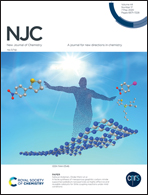Binding study on 1-adamantylalkyl(benz)imidazolium salts to cyclodextrins and cucurbit[n]urils†
Abstract
Multitopic guests are used as key components of molecular triggers, switchers, sensors, or reactors in recent supramolecular chemistry studies. The increasing complexity of these compounds correlates with the need for versatile, synthetically available binding motifs (building blocks) with tuneable supramolecular properties. The utilisation of a favoured 1-adamantylmethyl moiety in ammonium, imidazolium and pyridinium salts is sometimes restricted by synthetic difficulties most likely related to the adamantane cage bulkiness. Therefore, we prepared a series of new adamantylated (benz)imidazolium salts with longer flexible linkers between the adamantane cage and cationic moiety. We tested the supramolecular properties of these binding motifs towards the natural cyclodextrins α-CD, β-CD and γ-CD and cucurbit[n]urils (n = 7, 8) using NMR, mass spectrometry and titration calorimetry. All tested guests formed 1 : 1 complexes with the abovementioned hosts, retaining binding strengths, selectivity, and complex geometries in comparison to the parent methylene-linked homologues. We did not confirm our original concern that longer linkers would negatively affect the binding strength towards CBns due to the reduction in the ion–dipole interaction contribution. Therefore, we believe that adamantylalkyl imidazolium binding motifs can be used for multitopic supramolecular guest construction.
![Graphical abstract: Binding study on 1-adamantylalkyl(benz)imidazolium salts to cyclodextrins and cucurbit[n]urils](/en/Image/Get?imageInfo.ImageType=GA&imageInfo.ImageIdentifier.ManuscriptID=D0NJ00738B&imageInfo.ImageIdentifier.Year=2020)


 Please wait while we load your content...
Please wait while we load your content...